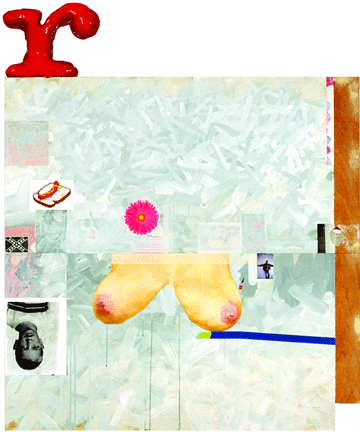Michael St. John hits all the marks
In the mid-19th century, the French poet and art critic Charles Baudelaire published his famous essay, “The Painter of Modern Life.” He proposed a new model of the artist as an individual who was simultaneously immersed in and detached from the miasma of contemporary urban life.
In our time, Baudelaire’s concept is pervasive. It is particularly noticeable among the many artists, whether they are aware of him or not, who make work that has a critical or empathic relationship to our common commercial culture. Michael St. John, a mid-career artist and denizen of midtown Manhattan, is an interesting contemporary manifestation of this formulation.
His current show has eight of his own recent works plus 10 contributions by other artist friends. The announcement card consists of a bushy-haired-and-bearded color portrait of him at 19 with the words, “I’m a child of divorce. Gimme a break” emblazoned across it, a verbal appropriation from a T-shirt, most likely. St. John moved to New York City in the early ‘70s where he hung out, went to galleries and clubs, and took a few art courses. He spent his years “just observing” he states, and his work surfaced in the gallery system when he was older than many of his contemporaries. This is relevant to Baudelaire’s model artist, who desired anonymity, though he was a “Man of the World” who derived his artistic experiences outside of the academy. St. John has become an important teacher and independent curator, but he has not been fresh-squeezed from the Yale-Columbia-UCLA fine arts graduate program pipeline.
Baudelaire’s ideal artist was a flaneur or stroller, and most of St John’s work re-creates a stroll through his local neighborhood, Times Square, which serves him well as an intense physical duplication of our contemporary environment of televised and virtual signage and display. The paintings are festooned, to the point of being clogged, with imagery from advertising, pornography, photojournalism, and the artist’s personal history. To St. John, all these worlds are homogeneous. Most of his works contain real objects as well, and the show also has some of his sculptures, which are derived from everything from sneaker logos to imagery from recent famous paintings.
The work performs a soulful, delirious recapitulation of the constant forced imagery, the manipulations by every product and opinion vying for one’s attention, the restless false eagerness of mass media that accompanies what intimacy is available in our day-to day existence. Baudelaire’s flaneur was an empathetic character who loved crowds, and it follows that St. John would mount other works among his own, as if to indicate that he sees art-making as a social activity – his work communicates alongside other works doing the same. In his life as well as his art, St. John appears to hit all the marks, at least according to one important standard of measurement.
gaycitynews.com



































